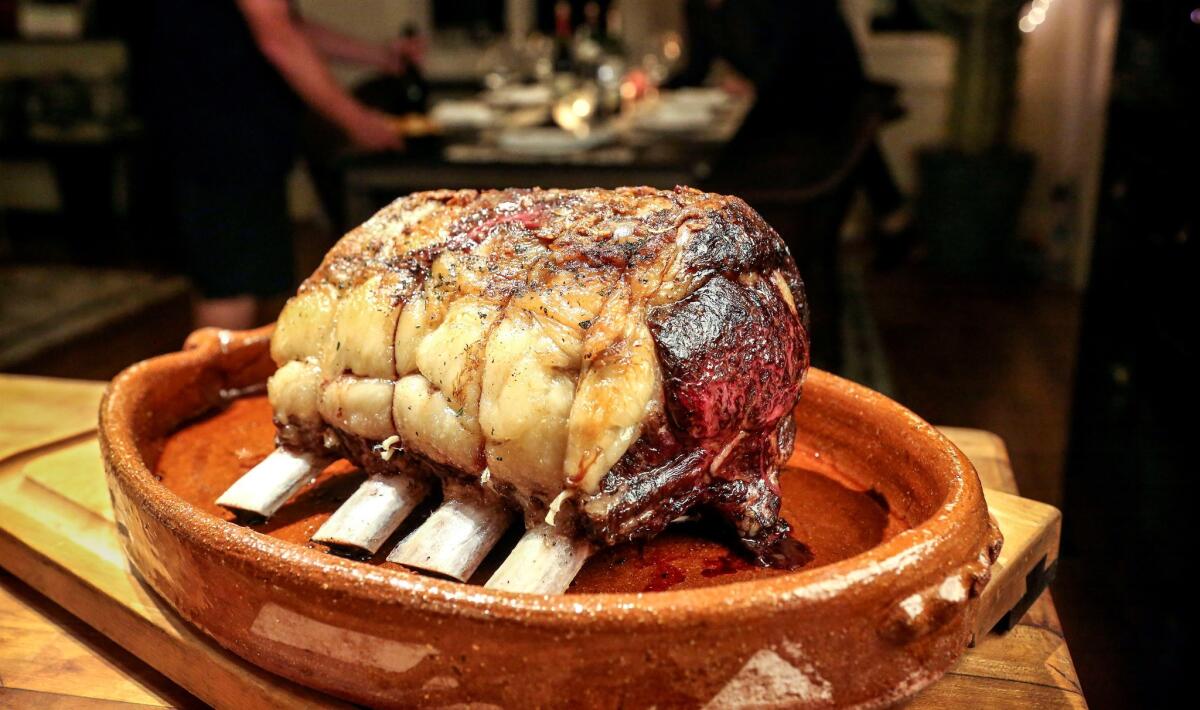Five easy steps to perfect roast beef

- Share via
Big holidays mean big roasts. But all too often they also mean big disappointments. Shell out a hundred bucks for a festive prime rib and anything less than great is a big letdown. But here’s a little secret: The truth is that there are few things easier to do.
Despite Brillat-Savarin’s much-quoted aphorism, “We can learn to be cooks, but we must be born knowing how to roast,” preparing roast beef is dead simple. Remember, he was writing at a time before regulating ovens and instant-read meat thermometers.
There are only a few key elements to preparing a perfect roast.
- Salt it early enough that it has a chance to season through. That’s the lesson of the late, great Judy Rodgers, and it’s as true for prime rib as it is for turkey (in fact, she recommended the same 1 tablespoon for every 5 pounds of weight). Give the roast at least a couple of hours after salting and preferably a couple of days.
- Cook it low and slow. Set the oven at 300 degrees at a maximum, or as low as 225 degrees, if your oven can hold that temperature reliably.
- Cook the roast to an internal temperature of 125 degrees. Don’t worry, that’s not going to be bloody rare. With a large cut of beef such as a roast, you can count on the temperature rising between 5 and 10 degrees after you’ve pulled it from the oven.
- If you want a deeper, browner crust, when the meat reaches 115 degrees, push the oven as hot as it will go for 10 or 15 minutes, still pulling the roast when it reaches 125 degrees.
- Let the meat rest for at least 30 minutes and preferably an hour before carving. This will allow the carryover cooking to push the interior temperature to 130 to 135 — a perfect medium-rare, rosy and juicy but with set fibers and softened fat — and it will allow the juices that have been drawn to the surface during cooking to redistribute throughout the meat.
Which cut of beef to roast? There’s a confusion of names. Most of these festive roasts come from the same muscle — the longissimus dorsi — the loin that runs along the back of the animal.
So-called prime rib, which isn’t necessarily prime, is the same as a standing rib roast. It can come in three subcategories: The first rib roast is usually 5 to 8 pounds and comes from the 11th and 12th ribs. It holds most of the rib-eye and is the most expensive cut. Center-rib roasts weigh about the same amount and hold a smaller portion of the rib-eye. They are less expensive. There is also a sixth and seventh rib roast; this is fattier and has more meat from the tougher shoulder and chuck, but some prefer the flavor. The same cuts without the bones are called rib-eye or Delmonico roasts.
Those are the basics, and very delicious basics they are. If you’re interested in different ideas, here is S. Irene Virbila’s technique, photographed above, as well as three full recipes to get you started, beginning with one of my favorites.
RIB ROAST WITH TAPENADE
Total time: 2.5 hours | Serves 8
6 ounces pitted black olives
3 cloves garlic, divided
4 anchovy filets
3 sprigs rosemary, leaves removed
About 1/4 cup red wine
1 (3.5 to 4-pound) standing rib roast
Freshly ground pepper
3/4 cup fresh bread crumbs
1/2 teaspoon minced fresh rosemary
Olive oil, optional
12 baguette slices, toasted
1. Pulse the olives, 2 cloves of garlic, anchovies and rosemary leaves in a food processor. Add just enough red wine to allow the mixture to form a fairly smooth paste.
2. Score the fatty sides of the rib roast in a diamond pattern, using a sharp knife to cut through the fat but not into the meat. Smear the top and both sides of the roast with the olive mixture, season generously with pepper and let it stand at room temperature 30 to 45 minutes to marinate. Reserve any leftover olive mixture.
3. Heat the oven to 300 degrees. Carefully transfer the rib roast to a shallow roasting pan, bone-side down. Disturb the olive smear as little as possible. Roast to an internal temperature of about 115 degrees. This will take about 2 hours.
4. In a food processor, pulse the bread crumbs, remaining clove of garlic and the 1/2 teaspoon of rosemary until the garlic is minced fine. Remove the roast from the oven and pat the seasoned bread crumbs over top. Spoon over some of the fat from the bottom of the pan and return the roast to the oven. (If there is very little fat, sprinkle about 1 tablespoon of olive oil over the crumbs.) Continue roasting to an internal temperature of 125 degrees, about 20 minutes more.
5. Remove the roast from the oven, cover it loosely with foil and let it stand an additional 15 minutes before carving. Use the remaining tapenade to smear on the toasted baguette slices and serve it alongside the carved roast, dipped in the juices.
Each serving: 558 calories; 532 mg. sodium; 97 mg. cholesterol; 36 grams fat; 14 grams saturated fat; 26 grams carbohydrates; 30 grams protein; 1.89 grams fiber.
Are you a food geek? Follow me on Twitter @russ_parsons1
More to Read
Eat your way across L.A.
Get our weekly Tasting Notes newsletter for reviews, news and more.
You may occasionally receive promotional content from the Los Angeles Times.










